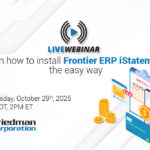
Enterprise Resource Planning (ERP) systems are important for managing the large amount of data your company collects. ERP advanced reporting and analytics tools help you see a holistic view of your company and its performance. These tools allow you to make data-driven decisions for improved efficiency and help align your business for the future.
This blog post explores ERP advanced reporting features and how you can use them to track, monitor, and improve your business operations.
Understanding ERP Advanced Reporting and Analytics
Advanced reporting in ERP systems goes beyond basic report generation. It involves the creation of customizable, detailed reports that cater to specific business needs. These reports can be tailored to display the exact data points and metrics that matter most to your organization.
On the other hand, analytics involves using data analysis tools to interpret and visualize data. This includes:
- Predictive analytics: to forecast future trends
- Prescriptive analytics: to recommend actions
- Descriptive analytics: to understand past performance
- Integrative analytics: to combine data from various sources for a comprehensive view.
“Technologies are often implemented without yielding the results envisioned and become overly complex to maintain as new needs are built into an inflexible architecture,” according to a Deloitte article on ERP reporting. Why? The article notes that some companies lack an overall ERP reporting strategy to integrate and sync data to their objectives.
Key ERP Analytics & Reporting Features

Dive deep into your company’s data with Frontier ERP’s advanced reporting and analytical tools.
ERP reporting features are crucial for manufacturers because they provide real-time visibility into processes for effective resource management. These features help track key performance indicators (KPIs), identify inefficiencies, and forecast demand, ultimately improving productivity and profitability.
- Customizable Reports: One of the standout features of advanced reporting is the ability to customize reports. This means you can create reports focusing on the specific metrics and KPIs crucial to your business. From tracking production efficiency to financial performance, customizable reports ensure you get the exact insights you need.
- Real-Time Data Access: Advanced reporting tools access up-to-the-minute data from your ERP system for faster and more informative decision-making.
- Interactive Dashboards: Visualizing data makes it easier to interpret and act upon. Interactive dashboards allow you to see your data in various formats, such as charts, graphs, and tables. These dashboards are highly functional, providing a quick overview of key metrics at a glance.
- Automated Report Generation: Manual report generation is time-consuming and prone to errors. Advanced reporting tools automate the process, generating accurate and timely reports without manual intervention. This automation frees up valuable time for your team to focus on more strategic tasks.
Benefits of Advanced Reporting for Manufacturers
Advanced reporting is very beneficial to manufacturers. ERP reports can provide detailed insights into your operations, helping identify inefficiencies and track performance across the company. Plus, customizable reports and third-party data integration enable data-driven decisions that enhance productivity and profitability. This provides you with the opportunity for continuous improvement and sustainable growth for your manufacturing business.
- Improved Decision-Making: Data-driven decisions are more likely to be accurate and effective. Advanced reporting and analytics provide the insights needed to make informed choices that can positively impact your bottom line.
- Enhanced Operational Efficiency: By identifying bottlenecks and inefficiencies, advanced reporting tools help streamline operations. This leads to increased productivity and reduced waste.
- Better Financial Management: Advanced reporting provides a clear view of your financial performance. This includes tracking costs, revenues, and profitability, allowing for better financial planning and management.
- Enhanced Customer Satisfaction: Understanding customer needs and behaviors is key to providing better service. Advanced analytics help you analyze customer data, leading to improved customer satisfaction and loyalty.
Where Advanced Reporting Can Help
ERP systems can generate a variety of reports essential for managing different aspects of your manufacturing business. These reports provide detailed perspectives that can impact strategic planning goals and initiatives. Here are some ERP report types that are commonly generated:
1. Finance
- Balance Sheet: Provides a detailed view of company assets, liabilities, and shareholders’ equity at a specific point in time. It helps stakeholders understand the financial stability and liquidity of the business.
- Income Statement (P&L): Furnishes revenues, expenses, and profits for a specific time, like a quarter or a year. P&Ls are necessary for assessing the company’s financial performance.
- Cash Flow Statement: Shows the cash inflows and outflows from operations, investing, and financing activities. This statement is vital for managing liquidity and ensuring the company can meet its short-term obligations.
- General Ledger: Supplies a comprehensive record of all financial transactions over the life of the company. It supports financial statement preparation and helps in tracking all financial data.
- Product Costing: Provides valuable insights into the costs associated with manufacturing a product. This report helps manufacturers understand the total cost of production, identify cost-saving opportunities, and set accurate pricing strategies to maintain profitability.
2. Sales and Service
- Sales Order Summary: Lists all sales orders, including order dates, customer details, product descriptions, quantities, and order statuses. It helps in tracking the sales pipeline and fulfillment status.
- Sales Performance: Evaluates sales performance by tracking key metrics such as sales volume, revenue, and conversion rates. It can be broken down by sales team, individual salesperson, product, or region.
- Customer Activity: Tracks customer interactions, orders, and payments internally and from customer portals, providing insights into customer behavior and trends. It helps in improving customer relationship management.
- Field Service: Provides detailed information on service calls, technician assignments, job completion times, customer feedback, and parts used. This report helps you monitor the efficiency of your field service calls.
3. Inventory
- Inventory Valuation: Critical for financial reporting and inventory management, valuation shows the total value of inventory at a specific time. It considers factors like the cost of goods sold (COGS), carrying costs, and market worth.
- Stock Movement: Details the movement of stock into and out of the inventory, including purchases, sales, returns, and transfers. It helps in monitoring inventory levels and identifying discrepancies.
- Reorders: Indicates which items need to be reordered based on predefined reorder points and lead times. This helps in maintaining optimal inventory levels and preventing stockouts.
4. Production
- Work Order Status: Tracks the status of work orders through different stages of production. It helps in managing production schedules and identifying bottlenecks.
- Production Schedules: Outlines the planned schedule for production activities, including start and end dates, assigned resources, and progress tracking. It ensures the timely completion of production tasks.
- Real-Time Tracking: Using real-time data feeds to monitor production processes, inventory levels, and other critical operations. This allows you to immediately take action should intervention be needed.
5. Supply Chain and Procurement
- Purchase Order Summary: Lists all purchase orders along with their details. These may include supplier information, order date, delivery date, items ordered, quantities, and order status. It helps in tracking procurement activities.
- Supplier Performance Report: Evaluates suppliers based on key metrics such as on-time delivery, product quality, and cost. It aids in supplier selection and performance improvement.

Advanced reporting and analytics tools help you see a holistic view of your company to make more informed, strategic decisions.
- Goods Received Note (GRN): Confirms the receipt of goods from suppliers, detailing the items received, quantities, and conditions. It is crucial for inventory management and accounting purposes.
- Distribution Requirments Planning (DRP): Key to ERP supply chain management, DRP reports provide insights into inventory needs across distribution centers and locations. This report helps ensure optimal inventory management and facilitates efficient distribution of products to meet customer demand.
6. Human Resources
- Employee Performance: Tracks employee performance metrics such as productivity, goal achievement, and performance reviews. It helps in managing talent and improving workforce efficiency.
- Attendance and Leave: Monitors employee attendance, absences, and leave balances. It supports workforce planning and payroll processing.
- Payroll: Details salary disbursements, deductions, taxes, and other payroll-related information. It ensures accurate and timely payment to employees and compliance with labor laws.
- Labor Utilization: Furnishes details on how labor resources are utilized within your manufacturing business. This report helps management assess workforce efficiency, identify areas for improvement, and make informed decisions regarding staffing, training, and resource allocation.
7. Lean Manufacturing
- Value Stream Mapping: Visualizes the flow of materials and information through the production process. It identifies waste and areas for improvement to streamline operations.
- Cycle Time Analysis: Measures the time taken to complete a process from start to finish. It identifies bottlenecks and helps in reducing cycle times to improve throughput.
- Resource Allocation: Tracks the allocation and utilization of resources (e.g., personnel, equipment) across various projects. It aids in optimizing resource use and preventing overallocation.
8. Compliance and Audits
- Audit Trail: Logs all changes and transactions within the ERP system, providing a detailed record for auditing purposes. It ensures accountability and traceability of financial and operational activities.
- Compliance: Ensures that the company meets regulatory and industry standards, such as financial regulations, safety standards, and environmental guidelines. It helps in avoiding legal penalties and maintaining good corporate governance.
9. Operations
- Daily Operations: Summarizes daily business activities and performance metrics, such as production output, sales, and service levels. It provides a snapshot of the day’s performance.
- Capacity Planning: Analyze production capacity against demand forecasts to optimize resource allocation.
- Cost Analysis: Analyze operational costs, including production, labor, and overhead, to identify areas for cost reduction.
10. Continuous Improvement
- Root Cause Analysis: Using data to identify the root causes of issues or inefficiencies in manufacturing processes and implementing corrective actions.
- Benchmarking: Comparing performance metrics against industry standards or competitors to identify areas for improvement.
- Process Optimization: Using insights from data analysis to optimize production processes, reduce waste, and improve overall efficiency.
Frontier’s Robust Analytics and Reporting
Frontier ERP features a comprehensive suite of built-in and customizable reports, ready for immediate use. From real-time data to demand forecasting, we help you proactively gain insight into your data with Frontier ERP software.
 With Frontier’s single source of truth database, you can access a wide range of operational and historical data. Our ERP allows you to take a deep dive into all supported business functions. Want details on sales, purchasing, inventory, and production? They are right at your fingertips!
With Frontier’s single source of truth database, you can access a wide range of operational and historical data. Our ERP allows you to take a deep dive into all supported business functions. Want details on sales, purchasing, inventory, and production? They are right at your fingertips!
To access this business intelligence, our tools integrate standardized ERP reporting techniques with data mining and customizable reporting tools. These tools generate detailed reports that are easy to understand and utilize, helping you improve your operations.
Utilizing barcoding or RFID technology, our RF reporting tool automatically generates reports within Frontier ERP. It provides detailed tracking and analytics for material and personnel activities, work steps, transactions, and stock and customer-specific products.
Want more from your data? With our open architecture, you can easily add data from any ODBC-compliant app or Qlik integration. Frontier ERP data can be exported and combined with third-party data sources for more in-depth analysis.
Frontier’s advanced reporting and analytics tools, combined with Friedman’s industry expertise, help manufacturers uncover actionable insights that drive operational excellence and sustainable growth. Are you ready to get the most from your ERP data? Our dedicated team of experts is available to provide a demo today!





